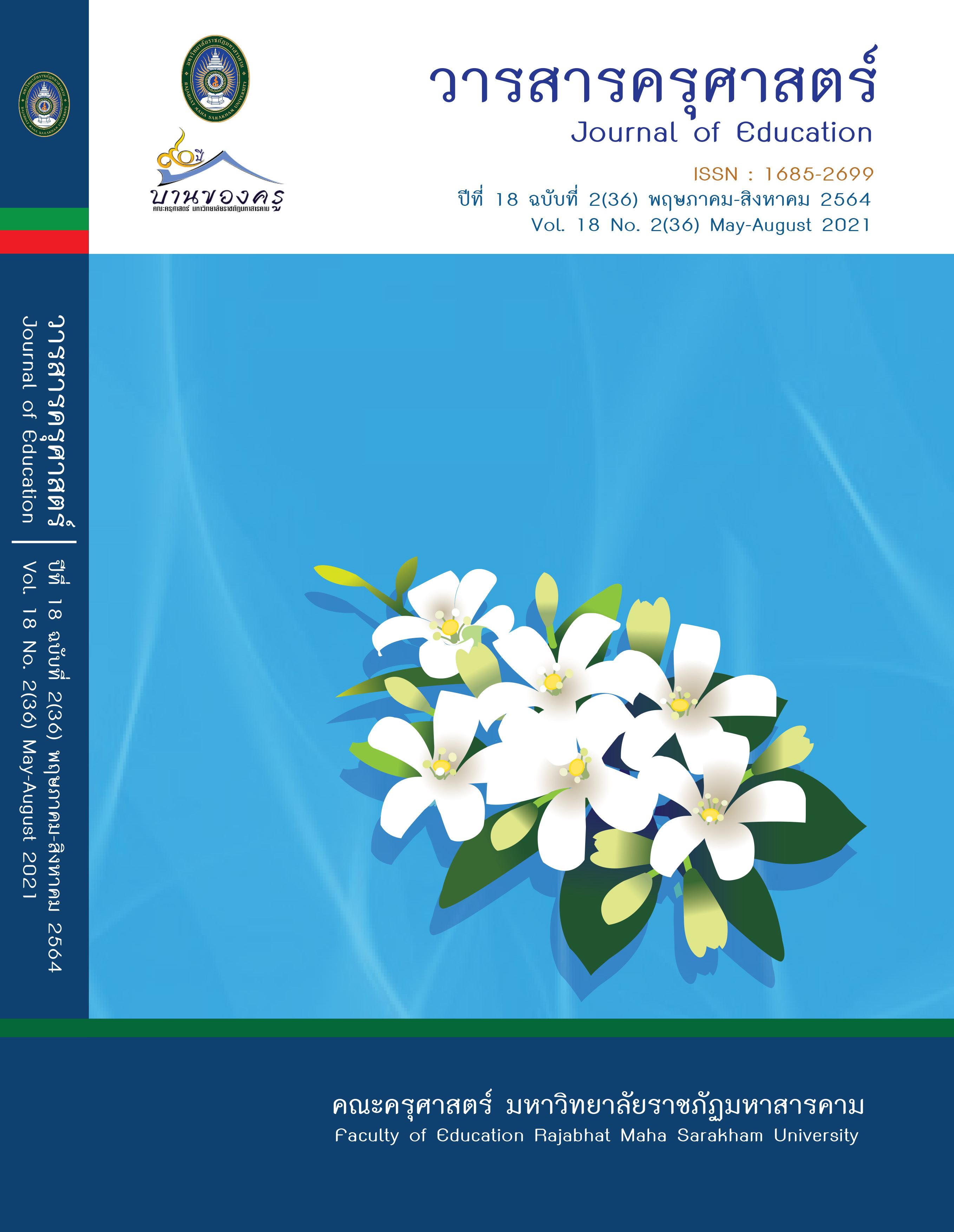EDUCATIONAL SCIENTIFIC CONCEPTIONONRESPIRATORY SYSTEMBY USING ANALOGY TEACHING APPROACH FAR GYIDE FOR GRADE 11 STUDENTS INRAJABHAT MAHA SARAKHAM UNIVERSITY DEMONSTRATION SCHOOL
Main Article Content
Abstract
The purposes of this research study were: 1) to develop scientific conception onRespiratory systemfor grade 11 students using analogy approach Focus-Action-Reflection (FAR guide) to pass scientific conception at partial understanding level, and 2) to study the satisfaction of the learners towards the processes of learning analogy approach (Focus-Action-Reflection–(FAR) guide. The target group was 20 students in grade 11 students Rajabhat MahaSarakham University Demonstration School, studied in the 2nd semester of academic year 2020. Action Research was used in this study. The research instruments were: 1) Six plans of design learning by Analogy Approach to implement the recommendations of the Focus Action Reflection Guide (FAR Guide), 2)Two-tier multiple choice scientific conception test, and 3) A satisfaction questionnaire of the students. The statistics used for data analysis were mean and percentage.
The research found that: The first action cycle, the students had percentage average of 27.19 The second action cycle, the students had percentage average of 61.25. The third action cycle, the students had percentage average of 80.31. At the 3th cycle action research, all students have understand in Scientific Conception level of PU which is consistent with the first research purpose. Students’ satisfaction of using learning actives analogy teaching approach for grade 11 students on Respiratory System showed at the highest level with an average score of 4.68.
Article Details
ข้อกำหนดเบื้องต้นที่ผู้นิพนธ์(ผู้ส่งบทความ) ควรทราบ
1. ผู้นิพนธ์ที่ประสงค์จะลงตีพิมพ์บทความกับวารสาร ตั้งแต่เดือนมกราคม 2563 เป็นต้นไป ให้ใช้รูปแบบใหม่ (Template 2563) โดยสามารถดูตัวอย่างได้ที่เมนู GUIDELINES
2. จะตีพิมพ์และเผยแพร่ได้ ต้องผ่านการประเมินจากผู้ทรงคุณวุฒิ (Peer Review)
3. การประเมินบทความโดยผู้ทรงคุณวุฒิ (Peer Review) เป็นแบบ Double Blind
4. การอ้างอิงบทความใช้หลักเกณฑ์ APA (American Psychological Association) คลิก
5. บทความถูกปฏิเสธการตีพิมพ์ ไม่ผ่านการประเมิน ผู้นิพนธ์ขอยกเลิกเองหรือชำระเงินก่อนได้รับการอนุมัติ ทางวารสารไม่มีนโยบายการคืนเงิน
References
ชุติมา ธนาวัฒนากร. (2562). การพัฒนาการจัดกระบวนการเรียนรู้แบบสืบเสาะหาความรู้5Eโดยใช้สื่อประสม เรื่องซอฟต์แวร์ประมวลผลคำ (Microsoft word 2013) ชั้นประถมศึกษาปีที่ 5. วารสารเทคโนโลยีและสื่อสารการศึกษามหาวิทยาลัยมหาสารคาม,3(7), 9-23.
พรรณวรินทร์ วงษ์หอม. (2557). การศึกษาตัวแทนความคิด เรื่อง ระบบไหลเวียนเลือดของมนุษย์ของนักเรียนชั้นมัธยมศึกษาปีที่ 2 โรงเรียนโชคชัยสามัคคี โดยใช้วิธีการสอนแบบเปรียบเทียบ (Analogy) ตามแนว Focus Action Reflection Guide (FAR Guide).[วิทยานิพนธ์ปริญญามหาบัณฑิตไม่ได้ตีพิมพ์].มหาวิทยาลัยขอนแก่น.
ยุภาวดี โคตรทอง. (2557). ศึกษาการเปลี่ยนแปลงมโนมติของนักเรียนชั้นมัธยมศึกษาปีที่ 4 ในการเรียนรู้วิชาชีววิทยา เรื่องเซลล์ โดยใช้การสอนแบบเปรียบเทียบ. [วิทยานิพนธ์ปริญญามหาบัณฑิตไม่ได้ตีพิมพ์].มหาวิทยาลัยขอนแก่น.
ยุภาวดี โคตรทอง และหล้า ภวภูตานนท์. (2558). ศึกษาการเปลี่ยนแปลงมโนมติของนักเรียนชั้นมัธยมศึกษาปีที่ 4 ในการเรียนรู้วิชาชีววิทยา เรื่องเซลล์ โดยใช้การสอนแบบเปรียบเทียบ.วารสารศึกษาศาสตร์ฉบับวิจัยบัณฑิตศึกษามหาวิทยาลัยขอนแก่น,9(3), 157-164.
รัชนก กันชม. (2562).การพัฒนามโนมติทางวิทยาศาสตร์ เรื่อง การสืบพันธุ์ของพืชดอกและการเจริญเติบโตโดยใช้กิจกรรมการเรียนรู้แบบสืบเสาะหาความรู้ 7 ขั้นร่วมกับกลวิธีการเดินชมแลกเปลี่ยนเรียนรู้ (Gallery Walk) ของนักเรียนชั้นมัธยมศึกษาปีที่ 5. [วิทยานิพนธ์ปริญญามหาบัณฑิตไม่ได้ตีพิมพ์]. มหาวิทยาลัยมหาสารคาม.
ฤทธิชัย เสนาพรหม. (2557). การเปลี่ยนแปลงมโนมติทางวิทยาศาสตร์ เรื่อง การสลายโมเลกุลสารอาหารแบบใช้ออกซิเจน ของนักเรียนชั้นมัธยมศึกษาปีที่ 4 เมื่อใช้รูปแบบการสอนแบบตามแนวคิด Focus – Action – Reflection (FAR) Guide. [วิทยานิพนธ์ปริญญามหาบัณฑิตไม่ได้ตีพิมพ์].มหาวิทยาลัยขอนแก่น.
ลัดดาวัลย์ สาระภัย. (2560). การพัฒนาผลสัมฤทธิ์ทางการเรียนและพฤติกรรมการเรียนรู้วิชาชีววิทยาเรื่อง การสังเคราะห์แสง ชั้นมัธยมศึกษาปีที่ 5 โดยใช้กระบวนการเรียนรู้แบบกระตือรือร้น (Active Learning).[วิทยานิพนธ์ปริญญามหาบัณฑิตไม่ได้ตีพิมพ์]. มหาวิทยาลัยราชภัฏมหาสารคาม.
วิชาการ โรงเรียนสาธิตมหาวิทยาลัยราชภัฏมหาสาราม. (2563). รายงานผลการทดสอบทางการ ศึกษาระดับชาติขั้นพื้นฐาน O-NET วิชาวิทยาศาสตร์ของนักเรียนชั้นมัธยมศึกษาปีที่ 6.มหาสารคาม. (เอกสารอัดสำเนา).
ศิริโสภาคย์ บูรพาเดชะ. (2553). แรงจูงใจกับการทำงาน. ธีรฟิล์มและไซเท็กซ์.
Duit, R, (1991). On the role of analogies and metaphors in learning science. Science Education, 75(6), 649-672.
Glynn, S. M. (1989). The teaching with analogies model: Explaining concepts in expository texts. In K. D. Myth (Ed.), Children’s comprehension of narrative and expository text: Research into practice (pp. 185-204). Neward, DE: International Reading Association.
Harrison, A. G., & Coll, R. K. (2008). Using analogies in the middle and secondary science classroom: The FAR Guide – an interesting way to teach with analogies. The United States of America.
Kemmis, S and McTaggart, R. (1998). The Action Research Planer. (3rd ed.). Deakin University.
Maslow, A. H. (1970). Motivation and Personality. (2nded). Harper and Row Publishres.Orgill, M., and Bodner, G. M. (2004). What research tells us about using analogies to teach chemistry. Chemical Education: Research and Practice, 5(1),15-32.


